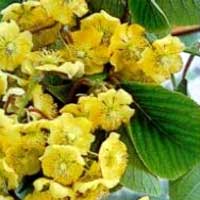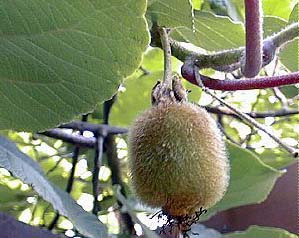Actinidia deliciosa
||  Russian
Russian
Kiwi fruit, Chinese gooseberry
click on image to enlarge

Origin: China. This is the kiwi fruit. The true Chinese gooseberry (A. sinensis)
is native to China, but the fruit we find at local markets is from New Zealand.
This lovely twiner, with its fuzzy leaves, is ideal for trellis growing. The plant
is a vigorous, woody, twining vine (liana) or climbing shrub. It is not unusual
for a healthy vine to cover an area 10 to 15 feet wide, 18 to 24 feet long and
9 to 12 feet high. In cultivation it is supported on a trellising system. The
large, deep green, leathery leaves are oval to nearly circular and 7 to 10 inches
in diameter. Young leaves and shoots are coated with red hairs, while mature leaves
are dark green and hairless on the upper surface, downy-white with prominent,
light colored veins beneath. The large (1 to 2 inch diameter), white to cream
colored flowers are somewhat fragrant and produced as singlets to triplets in
the leaf axiles. The flowering period extends over several weeks from early May
to June, depending on climatic conditions. The plants are dioecious, bearing either
male or female flowers, thus needing plants of both sexes to produce fruit. Self-fruiting
males are known to exist but produce less desirable fruit. The fruit itself is
shaped like a grape, the size of a small egg, and is chartreuse in color. Kiwifruit
prefer somewhat acid (pH 5 - 6.5), well-drained soils that are rich in organic
matter. Kiwifruit plants need large volumes of water during the entire growing
season but must also be in well-drained soils. Plants are heavy nitrogen feeders
which should be applied in abundance during the first half of the growing season.
Propagation: Because the kiwi is subject to damping off, sow the seed in a coffee
can or flat azalea pot; cover the surface of the soil thinly with vermiculite
to protect the susceptible stem-to-ground junction. It takes about eight weeks
for kiwi seed to germinate. If you have trouble sprouting the kiwi pits, give
them a cooling-off period in the refrigerator before the second attempt. This
is known as stratification. To do this, mix the dried seed with some sphagnum
moss in a plastic bag and store at 45F for about forty days. (This simulates the
natural germination cycle of the kiwi seed in nature.) Then replant the seed in
containers. You should have sprouts within three weeks. Transplant them when they're
a few inches high. In the home landscape, plant the kiwi where it will receive
full sunlight and give it copious amounts of water. The kiwi prefers temperatures
of 78F in the day and no less than 45 degrees F at night.
More
info about Kiwi fruit and other actinidia species.










